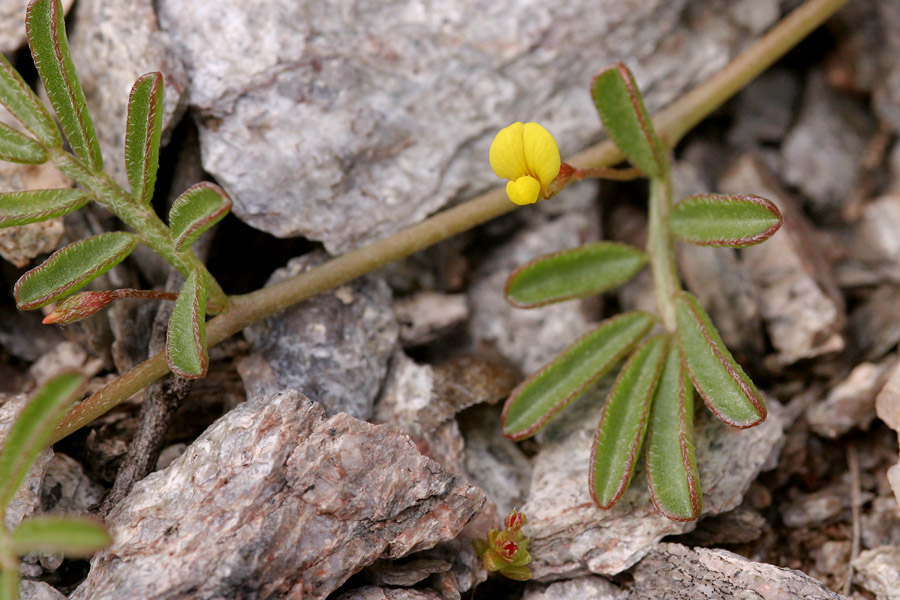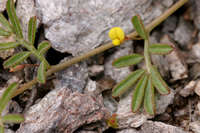Duration: Annual
Nativity: Native
Lifeform: Forb/Herb
General: Prostrate or decumbent annual with several spreading branches 5-35 cm long, sparsely strigose but only youngest parts cinereous; stems essentially glabrate or nearly so.
Leaves: Alternate, pinnately compound, fleshy, leaflets 4-9, oblanceolate to obovate, 3-10 mm long, curving in a v-shape (involute), usually strigose, at least along the margins, sometimes purplish, midstem (axis) usually flattened, stipules gland-like.
Flowers: Yellow to reddish-orange, with banner, wing, and keel petals (papilionaceous), 3-5.5 mm long, the wings larger than the keel, stamens 10, filaments with 9 fused, 1 free, stigmas puberulent, flowers axillary, solitary, or in groups of 1-2 on bracted peduncles.
Fruits: Pods purplish, narrow, cylindrical (terete), 1-3.5 cm long, generally curved only at or near the tip. Seeds several, kidney-shaped (reniform), glabrous.
Ecology: Found on sandy or gravelly soil below 3,000 ft (914 m); flowers February-May.
Distribution: Arizona, California, Nevada; Mexico.
Notes: The thickish, slightly succulent leaves are one feature to pay attention to.
Ethnobotany: Used for greens.
Etymology: Lotus is from the Greek and is originally applied to a fruit said to make those who tasted it forget their homes, strigosus means covered in straight, flat-lying hairs.
Synonyms: Hosackia tomentella, Lotus intricatus, Linnaeus tomentellus, Lotus strigosus var. tomentellus, Lotus tomentellus, Lotus strigosus
Editor: SBuckley, 2010
Plant: Annual, often fleshy, hairy or not; stem prostrate, generally branched from base
Leaves: stipules gland-like; leaflets 4-9, generally alternate, 3-10 mm, oblanceolate to obovate; axis ± flat, ± blade-like
INFLORESCENCE: 1-2-flowered; peduncle generally bracted
Flowers: calyx 3-5.5 mm, lobes < tube; corolla opening or not, 5-10 mm, yellow, turning orange or reddish, wings generally > keel; stamens 10, 9 filaments fused, 1 free; stigma puberulent
Fruit: legume, dehiscent, 1-3.5 cm, generally ± curved only at or near tip; Seeds several, often ± reniform, generally hard, smooth
Misc: Coastal scrub, chaparral, foothills, deserts, roadsides, other disturbed areas; < 2300 m.; Mar-Jun
References: Jepson Manual 1993




